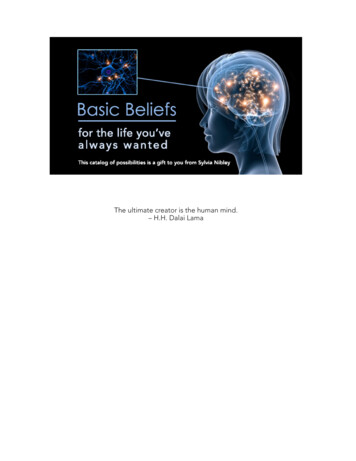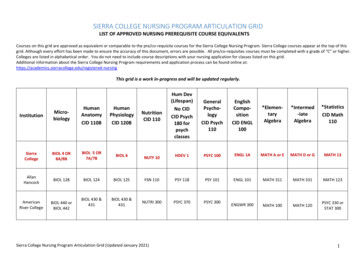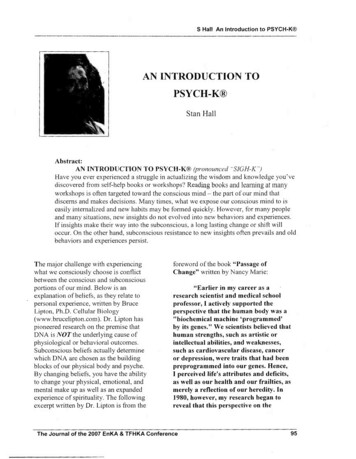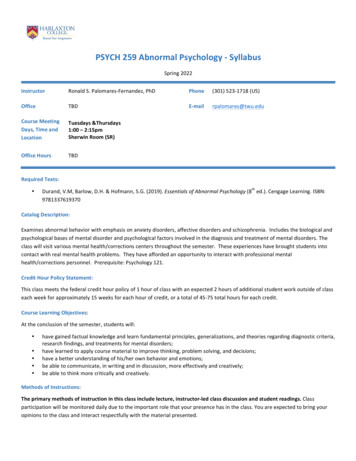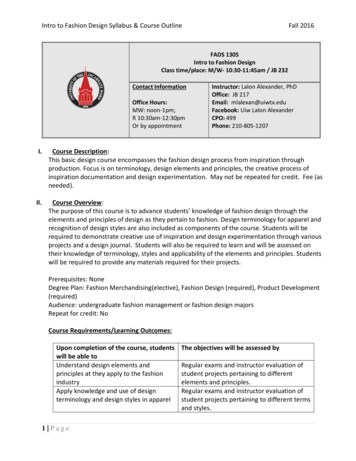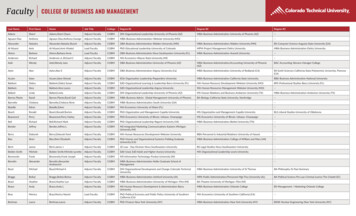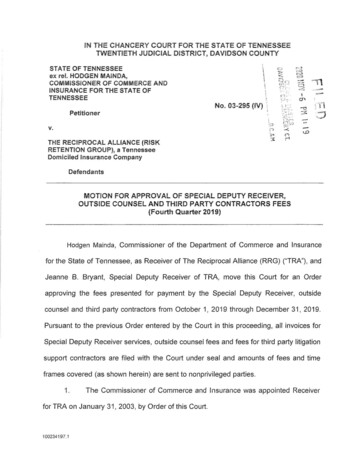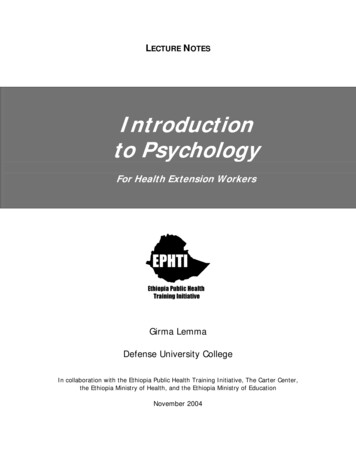
Transcription
LECTURE NOTESIntroductionto PsychologyFor Health Extension WorkersGirma LemmaDefense University CollegeIn collaboration with the Ethiopia Public Health Training Initiative, The Carter Center,the Ethiopia Ministry of Health, and the Ethiopia Ministry of EducationNovember 2004
Funded under USAID Cooperative Agreement No. 663-A-00-00-0358-00.Produced in collaboration with the Ethiopia Public Health Training Initiative, The CarterCenter, the Ethiopia Ministry of Health, and the Ethiopia Ministry of Education.Important Guidelines for Printing and PhotocopyingLimited permission is granted free of charge to print or photocopy all pages of thispublication for educational, not-for-profit use by health care workers, students orfaculty. All copies must retain all author credits and copyright notices included in theoriginal document. Under no circumstances is it permissible to sell or distribute on acommercial basis, or to claim authorship of, copies of material reproduced from thispublication. 2004 by Girma LemmaAll rights reserved. Except as expressly provided above, no part of this publication maybe reproduced or transmitted in any form or by any means, electronic or mechanical,including photocopying, recording, or by any information storage and retrieval system,without written permission of the author or authors.This material is intended for educational use only by practicing health care workers orstudents and faculty in a health care field.
AcknowledgmentsThe development of this lecture note for training Health Extensionworkers is an arduous assignment for Ato Fasika Melesse at DefenceUniversity College.Essentially, it required the consolidation and merging of existing indepth training materials, examination of Health Extension Packagemanuals and the Curriculum.Recognizing the importance of and the need for the preparation of thelecture note for the Training of Health Extension workers THECARTER CENTER (TCC) ETHIOPIA PUBLIC HEALTH TRAININGINITIATIVE (EPHTI) facilitated the task for Defence University to nsionCoordinating Office of the Federal Ministry of Health.Finally the Federal Ministry of Health would like to express specialwords of gratitude for those who contributed and endeavored to thedevelopment of this lecture note and to TCC/USAID for the technicaland financial support.i
Table of ContentsContent TopicPagesAcknowledgments ------------------------------------------ iTable of contents duction ------------------------------------------------- 1UNIT ONE: The Sociological PerspectiveTopic One: The Nature of SociologySociology defined -------------------------------------------- 2The study of sociology -------------------------------------- 2Sociology and social sciences --------------------------- 3Sociology and common sense --------------------------- 4Historical development of sociology -------------------- 5Topic Two: The Sociological ApproachMajor theoretical perspectives -------------------------- 7Sociology and social policy ----------------------------- 8ii
UNIT TWO: The Individual And SocietyTopic One: CultureCulture and society ------------------------------------------ 9Development of culture ------------------------------------ 10Elements of culture ------------------------------------------ 10Culture variation and integration ------------------------ 13Culture and dominant ideology -------------------------- 14Topic Two: SocializationSocialization defined -------------------------------------15The role of socialization ---------------------------------15The self and socialization -------------------------------16Socialization and the life cycle-------------------------16Agents of socialization -----------------------------------17Topic Three: Social Groups and OrganizationsUnderstanding groups -----------------------------------20Studying small groups -----------------------------------21Understanding organizations---------------------------21Formal organizations and bureaucracy--------------21Voluntary opic Four: Deviance and Social ControlSocial control aw and society -------------------------------------------25iii
The concept of deviance --------------------------------26Crime -----27UNIT THREE: Social In-EqualityTopic One: Social Stratification and Social MobilityUnderstanding stratification ----------------------------29Stratification by social class ----------------------------33Social mobility ic Two: Stratification by GenderGender identity and gender roles ---------------------35Gender role socialization -------------------------------35Women as the oppressed majority -------------------36Topic Three: Social Stratification by AgeAging and society ----------------------------------------40Aging locally and globally -------------------------------40Role transition in later life -------------------------------40Topic Four: Race and EthnicityMinority, racial and ethnical groups ------------------41Studying race and ethnicity ----------------------------42Prejudice and discrimination --------------------------43iv
Patterns of inter group relations -----------------------43UNIT FOUR: Social InstitutionsTopic One: The FamilyThe concepts of the family -----------------------------45The functions of the family -----------------------------46Marriage and the family ---------------------------------46Factors associated with divorce -----------------------47Topic Two: ReligionSociological approach to religion ---------------------48The function of religion ----------------------------------48Dimension of religion ------------------------------------49Topic Three: Health and MedicineAnthropological perspective on health andillness ------50Social epidemiology and health -----------------------52Factors that affect the distribution ofheath/illness -----------------------------------------------53v
UNIT FIVE: Social Research And Methodology:Anthropological ApproachTopic One: Concepts in Social ResearchDefinition of social research ----------------------------55The goals of social research ---------------------------55Topic Two: Research MethodologyData collections ---------------------------------------------- 58Survey -------- 58Observation -------------------------------------------------- 60Participant observation ------------------------------------ 61Research and Health Extension Workers ------------- 63Reference --- 64vi
Introduction to PsychologyUNIT ONEPsychology An OverviewGeneral Objective: At the end of the unit thetrainee willbe able to describe the introductoryaspects of psychology.1.1. Nature of PsychologySpecific objective: At the end of the lesson thetrainee will be able to describe thenature of psychology.Activity: Start the lesson by forwarding thefollowing brainstorming questions.Have you ever read any material or heard anythingrelated to psychology?Specify the source?Did you appreciate? Psychology originated from two Greek words i.e.,Psyche soulLogos study Psychology brokeaway from philosophy andphysiology and emerged as a separate disciplinesome 100 years ago.1
Introduction to Psychology since its emergence as a separate science it hasundergone a series of changes in its researchmethodology and definition.Widely used definition: Psychology is the science ofhuman and animal behavior.When explaining the definition underline the maincomponents of the definition. What is science? Steps in scientific Study Problemidentification(example:sanitary problems in the family) Data collection (family size, age,gender,expenditure,accesstopotable water) ,questionnaire, case studies, focusgroup discussions) Organizingthedataandreporting Based on the conclusions arrivedputting into practice Behavior is an action, activity or process thatwe can observe and measure indirectly.2
Introduction to PsychologyExample: to know health practices of a family we caninterview members of the family or head ofthe household by asking different questions.1.2 Scope of psychologySpecific objective: At the end of the lesson the trainee willbe able to state the scope ofpsychology.Activity: Start the lesson by asking this question (What isthe role of psychology in your future career?) Compared to other sciences psychology is a youngdiscipline but it is growing at afaster rate. Thesedays, directly or indirectly, psychology contributessomething to all aspects of human life. Explain thefollowing relationships: Psychology and politics. Psychology and economics. Psychology and health.1.3 Branches of psychologyLeading question In Biology the sub fields are zoology,botany, anatomy andphysiology. What do you thinkare the sub fields of psychology?3
Introduction to Psychology1.3.1 Educational psychology It is about Ways and methods of educating people.Example: Which seating arrangement (chairs inrows, chairs in smallgroups, chairs inaparticipationcircle)increasesofcommunity members in discussing thefollowing community problem. (How canwe protect the spring water in thecommunity to make it safe and clean?)Remind the trainees on the advantages of participatorylearning inhealth education in the acquisition of newknowledge and skills.1.3.2 Developmental psychology Deals with aspects of human developmentover the entire span of life. Span of life covers from conception to death. Aspects of human development are thefollowing: Physical Mental Social4
Introduction to Psychology1.3.3 Social psychology It is the study of how people’s thoughts, feelingsand actions are affected by others. Socialpsychologistsstudyaggressivebehaviors (example: violence, rape, alcoholismin thecommunity) Social psychologists study conflict betweengroups, communities, and ethnic groups andmethods of solving it.1.3.4 Behavioral psychology It is about the role of environment indeveloping behavior It is about ways of learning new knowledgeand skillsExample: When introducing a new way of thinking in healthstart from what community members alreadyknow and proceed from the known to theunknown. It is about shaping human behaviorusing rewards. Toilet training in children Dietary habit in the family Sanitation practices in the family5
Introduction to Psychology1.3.5 Clinical psychology It is about Psychological disorders and theirtreatment. It is about how to change the environment toprevent the prevalence of psychological disorders.Example: the role a health extension worker plays insensitizing the bad effects of khat, alcohol, andtobacco on health and productivityNote: indicate that there are traditional ways of healingpsychological disorders in our society.1.3.6 Health psychology Emphasizes the preventive aspect of healththan the curative aspect Health is not merely the absence of illness.Health is a state of physical, mental andsocial well-being .Example: Teaching about personal hygiene is not enough.But the family and the society at large mustparticipate in health programs. Recognizing therole of every member in the community isimportant to implement any health program.Assignment: ask the trainees to search for otherbranches of psychology.6
Introduction to PsychologyUNIT TWOHuman DevelopmentGeneral Objective: At the end of the unit trainees will beable to describe human development.2.1. Introduction to human developmentSpecific objective: At the end of the lesson the traineeswill be able to describe the introductory aspect of humandevelopment. Reflection: Start the lesson by review questionsfrom their previous experience. Which branch of psychologystudies development? What do you understand by theword development? Describeawell-developedpersonality? Development: It is the sequence of changes overa full span of life. developmentisabouthowthebiological infant turns into the socialadult.7
Introduction to Psychology development Is regulated by theinteraction of hereditary traits withenvironmental factors - (D H X E)Development Vs Growth:we use these two termsinterchangeably.More often we use growthto mean an increase in body size. Averagegrowthrateduringprenatalstageofdevelopment is shown below.ExampleAt 4 weeksthe embryo isone- fifth of an inchAt 8 weeksthe embryo is 1 inchAt 28 weeksthe fetus is 16 inchesAt 38 weeksthe fetus is 20 inches Development is a more general term indicating changesphysically, mentally andsocially. It also, explainspossible causes of changes in all areas.Principles of development1. Development is sequentialExample: motor development 2 monthsan infant raises his head. 4-7monthsshows improvement in handand eye coordination.8
Introduction to Psychology 7 months can sit up and stand up holding ora chair.2. Development is irreversible it is uni-directional it does not switch back and forth. Under normal condition we expect mental andsocial developments to go with biological development.3. Development is progressive change A lower level leads to a higher oneExample: In cognitive (mental) development theprogress is from sensory knowledge toabstract thinking.Activity: Form small groups and encouragetrainees to explain how the social networkof the child changes as his/her interactionwith his/her environment increases.Cribsneighborhoodfamily membersschool2.2. Stages of human developmentSpecific objective: At the end of the lesson the traineeswill be able to describe the stages ofhuman development.9
Introduction to Psychology2. 2.1.Nature or nurture Brain storming: Before you start explaining thetopicposethisquestion(whichfactorisresponsible in shaping human development;heredity or environment?) consider the case ofidentical twins. Remind the trainees that nature (heredity) ornurture (environment) issue was important evenin the past.Example: in the 1600 the English philosopher John ed the role of nurture) The French philosopher Jean Jacques Rousseauconsidered hereditary factors as most important(emphasized the role of nature) Developmental psychologists take middle position.They claim that both Heredity and Environmentinteractively shape human personality. ( D H x E)2.2.2. Stages of development Infancy The infant has a unproportional appearance(head is large in proportion to body)10
Introduction to PsychologyAlthough girls have less muscle tissue and weigh less than boys, on the average infantsare 20 inches tall and weigh seven and halfpounds at birth.Behavioral reflexes are present from the moment of birth.Example: Infants can react to stimuli such asgentle touch or moving light. It can extend and flex arms and legswhen touched, smack lips, chewfingers, grasp an object. During the first year of life nisbiologicalmaturation, even though, practicecan speed up the whole process. Sensory motor coordination canduring 1 monthstare at an attractive object during 2 and half monthsswipeatobject during 4-monthshands to catch the object11raisean
Introduction to Psychology during 5 monthsreachand grasp the object Childhood (preschool children) Development is rapid in all areas (physically,cognitive, and socially) during this stage Rate of growth is slower at this stage thaninfancy. There are changes in body proportion.Example: head growth is slow Trunk growth is rapidLimb growth is rapid Matured body proportion, increased strengthcoordination and developed nervous systemprovide foundation for increased psychomotorskills. At age 6 children achieve sufficient eye andhand coordination, timing, and fine musclecontrol to demonstrate any skill in this activity. The child develops language skills and entersthe world of knowledge and culture by askingthe why question. Vocabulary increases rapidly between 2 and 6years of age.12
Introduction to Psychology Each day on average, five to eight words, areadded to the child’sQuestion:-vocabulary.(why do we send children to school at theage of seven?) Childhood (middle childhood 6 (7) - 12 years) Physical growth begins to slow down. A adolescent growth spurt begins at the age of10 and 12 for girls and boys respectively. Muscle tissue increases and they growstronger. Motor development tends to be smooth accurateand well coordinated. Adolescence (18-25) It is a period between childhood and adulthood Puberty is a biological event in which hormonalchanges promote rapid physical growth andsexual maturity in both sexes. It is marked bymenarche (the first menstrual cycle in girls) andNocturnal emission (sperm ejaculation) in boys.Puberty is not a period by itself. It is a gate wayto adolescence.13
Introduction to Psychology Adolescents become sexually active, delinquent,be involved in drug and alcohol abuse, suicide,risk taking. At this stage they are also exposedto sexually (STD) transmitted diseases andschool failure. Family and school guidance arevery essential and helpful for adolescents tocope up with challenges of this period. Early maturation of boys may enhance selfimage, which is an advantage socially andathletically. For girls early maturation may resultin early sex which is a risk factor. Adulthood (20-60 years) It is a developmental stage in whichtypical life goals and concerns are takingshape. Typical life goals during adulthood arerelated to Education and family Children’s lives and personal property Good health, retirement, leisure and thecommunity. Typical concerns during adulthood arerelated to14
Introduction to Psychology Relationship with friends Occupational worries Health fearsNOTE: Social and personality development for all stages ofdevelopment are discussed under unit five.2.3. Theories of development2.3.1. Cognitive theory of development General The term cognitive came from the Latin wordcognosco which means to know. Cognitionreferstoacquisition,processing,organizing and the use of knowledge. Jean Piaget developed the cognitive theory ofdevelopment.Developmental stages Stage one: sensory motor stage (from birth up to twoyears) A child’s experience is based on an immediateperception of physical objects. Thinking is dominated by the here and now.15
Introduction to Psychology For the child out of sight is out of mind (example:hide his toy under the blanket for the child the toy isnon existent)Reason: language and memory are not developed. Stage two: preoperational stage (two to seven years) With developed language the child is nowcapable of thinking in the absence of the object. Now the child sees the world only from his ownpoint of view (example: The child says thatother people see me if I see them) The Child’s thought is also centered on only onefeature of a situation.Example: For a child at the preoperational stage sausageshaped bread is bigger than a ball shapedbread even though both are equal in their size. Stage three: Concrete operational stage (7 – 11 years) The child has the ability to think reversibly. Hecan easily understand that a sausage shape canbe changed into round shape and back tosausage shape without necessarily seeing theobject. The child has also the ability to see more thanone feature of an object. He can see for examplethe height, width and length of an object.16
Introduction to Psychology Stage four: Formal operational stage (11 years onwards) The ability to reason out abstractly withoutconcrete objects or events starts. It is a form of adult thinking. This helps thechild to learn science and mathematicsand other subjects set in the curriculummaterial.Implications: The health extension worker and parentsshould be aware of to the Child’slevel ofdevelopment. Active participation and interaction with theenvironment is important. Encouraging children to ask questions onseveral topics and encouraging them toexplore their environment develops theircognitive (mental) capacity.2.3.2. Psychoanalytic theory of developmentGeneral Sigmund Freud is the founder of thepsychoanalytic(1856-1939)17theoryofdevelopment
Introduction to Psychology Childrenpassthroughaseriesofdevelopmental stages. Failure in to resolve problems at a particularstage results in halting in development. Inpsychoanalysis this is called fixation. Fixation at a particular stage may result inadult emotional problems. Oral stage (from birth to one year) Activity is centered to the mouth and the childgains satisfaction from sucking. Fixation may be caused by: Over feeding, sometimesunprogrammed feeding FrustrationoftheChild’sbiological needs. Possible adult life characteristics are Addictions (smoking, alcoholism) Nail biting.Note: Emphasize the importance of breast-feeding forphysical and emotional development of the child.18
Introduction to Psychology Anal stage (second year of life) The child exercises withholding and expelling offeces. Important event at this stage is toilet training.Fixation may occur due to conflict betweenthe child’s need and adults’ restrictionsduring toilet training. Some parents areextremely strict and others are reluctant inthe training process. Possible adult life problems are excessive cleanlinessand orderliness.Reflection: encourage trainees to reflect toilet trainingpractices and their implications in our society. Phallic stage (three to six years) Day dreaming for sexual intimacy with parents ofopposite sex. Through the socialization process, however, boysand girls understand and change in their beliefsystem that this is forbidden wish. To avoid the sense of being guilty, they identifythemselves with parents of the same sex (how?) By adopting gender roles in thesociety.19
Introduction to Psychology By adopting moral norms in thesociety. Latency period (6 years to puberty) It is relatively a calm period. It is the time to learn basic social andintellectual skills. Genital stage (puberty)Reflection: Ask trainees to reflect on the landmarksof the onset of puberty. Hormonal changes due to biological maturity areimportant developments during this stage. Interest in sexual maturity begins. Adult’s sexual attitudes and feelingsbegin to develop.20
Introduction to PsychologyUNIT THREELearningGeneral Objective: At the end of the unit the trainee willbe able to describe learning.3.1. The nature of learningSpecific objective: At the end of the lesson the traineewill be able to describe the nature oflearning.Brain storming: Start the lesson by encouraging traineesto give their own definitions of learning Learning is a relatively permanent change of behaviordue to training and/ orexperience. Main components of the above definition are: Learners involve in the learning process. Learners are engaged in activities. In learning less emphasis is given to informationtransmission and greater emphasis is given to skilldevelopment and attitudinal change. Basic components of learning: briefly learning is afunction of:21
Introduction to PsychologyL SRCWhereL LearningS StimulusR ResponseC Consequence (some kind of reward or punishment) Drive The degree of desire to learn Expectation of the learner from the instructional process Stimulus A stimulus is any form of energy from theenvironment to which a person is capable ofreacting. When the learner is activated by a stimulus learningtakes place. In the learning process the learner should beprovided with adequate stimuli.Example: guidelines, principles, and steps. Response involves Reaction to environmental stimuli. Learning is not a spectator sport.22
Introduction to Psychology Response of the learners includes: Discussing about what they listen. Relating to past experience. Applying it to their daily activities.NB. Tell me and I will listen. Show me and I will understand.Involve me and I will learn. ReinforcementIt is the process of increasing the probability of a ionbetween a stimulus and its response. For example, ding with the community can increase thecooperation of the community. Provision of maternal andchild services encourages and reinforces mothers to seekthe services and increases utilization. Reinforcers are oftwo kinds. Primary reinforcers satisfy some kind of biologicalneeds.Example: food, warmth, and cessation of pain. Secondary reinforcers work when they are associatedwith primary reinforcesExample: Money.23
Introduction to PsychologyIt becomes a reinforcer when we use it to improve lifecondition in the family.3.2. Theories of learningSpecific objectives: At the end of the lesson the traineeswill be able to describe the theoriesof learning.3.2.1.Classical conditioning theory IvanPavlovRussianphysiologistandpsychologist and Nobel Prize winner in 1904developed the theory. Pavlov found that the mouth secretes salivawhen food is merely seen or smelled. Classical conditioning is a basic form oflearning in which a neutral stimulus results in aninvoluntary action. The basic steps in classical conditioning experiment are:A. Before conditioningResponse(Neutral stimulus)Pricking of the earSound of a bell24
Introduction to PsychologyB. During conditioningUnconditioned responseConditioned Stimulus(SALIVA)Sound of a bell (CS)(UCR) Meat (unconditioned stimulus UCS)C. After conditioningConditioned response(CS) alone(CR) saliva Unconditioned stimulus (ucs) in this case meat leads tounconditioned response(ucr) which is secretion of saliva. Secretion of saliva (UCR) to a piece of meat (UCS) isnatural. It is not learned. It is inborn. During conditioning or training the sound of the bell whichis the conditioned stimulus (CS) is transformed intoconditioned response (CR) saliva. UCR and CR are similar. In both cases it is secretion ofsaliva. But the CR is learned. It is the result of training orconditioning Some features of classical conditioning Extinction: when the sound of the bell ispresented repeatedly without the meat, the dog25
Introduction to Psychologystops secreting saliva. The relationship betweenthe two stimuli becomes loose.We call thisprocess extinction. Extinction is a form offorgetting. Spontaneous recovery: when the dogrestarts to secrete saliva after extinction.Example: If a khat addicted person after receivingtreatment is continuously exposed to khat,he may suddenly relapse in to khatchewing. Stimulus generalization: It is giving thesame responseto similar stimuli. Itmay or may not be appropriate.Example: If a student has learned that virus andbacteria cause infectious diseases and usesthese two words as if they are similar, hemade inappropriate generalization.3.2.2. Operant conditioning theory B.F. Skinner an American psychologist developedthe theory. Laboratory animals learn to press the lever in orderto obtain food.26
Introduction to Psychology Reinforcement is an important aspect of operantconditioning. When teaching the community about health relatedtopics, it is essential to engage the learners in somerelevant activity directly related to the task at hand.Example: When community members bring some kind ofbehavioral changes with respect to health withinthe families and within the community, it isessential to reward (material or moral) them.3.3. Dynamic components of learning3.3.1.Motives of learning They are interests or drive, which cause aperson to behave in a certain way.Example: motive of getting scientific knowledge aboutthe preventive aspect of health. Motives of learning occur when: A student is inspired to work hard. When the trainer makes learning interestingand easier to learn. When learning is relevant to the extensionworkers future career.27
Introduction to Psychology3.3.2 Attitudes of learning Attitudes: It is a tendency to behave or think in acertain way. For example, one health worker mayrefuse to see patients when the health center isclosed. Another may be willing to see patients at anytime. This is because they have different attitudes totheir job. Attitudes are formed or changed during training. Like knowledge and skills attitudes are not easy tomeasure.Example: Teaching Health workers how to inject a patientis a skill. Explaining to health workers aboutthe importance of respecting the opinion ofpatients is trying to change the attitudes ofhealth workers. But it is difficult to find outwhether the health worker’s attitudes havechanged or not. Measuring attitude is moredifficult than measuring skill and knowledge. General methods to shape attitudes. Providing informationExample: the relationship between smoking of cancer andheart diseases.28
Introduction to PsychologyExercise: What facts are you going to mention to thecommunity if you want to persuade a mother tohave a positive attitude towards breast-feeding? Providing positive models (settingideal persons or examples in thesociety, teachers, nurses, doctors,other health extension workers) ce,forexample, seeing health sufferings ofthe community will have more inputon shaping students attitudes).Example: students may grow vegetables in their trainingcompound and experience its nutritional valuein the community. Students should practically see thebenefits of an uncontaminated watersupply in a villageExercise: Ask your students to list three experiences thatwould help them to form good attitudes toclients. Conduct discussion in small groupsto shape attitudes of student.29
Introduction to Psychology Discuss the experiences that theyhave had with clients. Let some students say their opinionsandseethereactionofotherstudents. Sample questions for discussions How would you st
Introduction to Psychology 7 UNIT TWO Human Development General Objective: At the end of the unit trainees will be able to describe human development. 2.1. Introduction to human development Specific objective: At the end of the lesson the trainees will be able to describe the i

